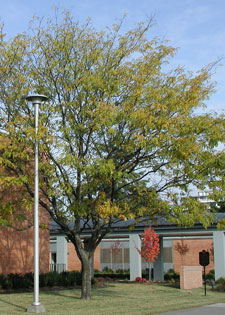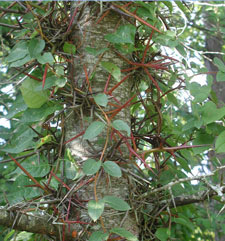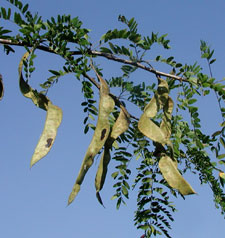Resource Library
Plant of the Week: Locust, Honey
The University of Arkansas System Division of Agriculture does not promote, support or recommend plants featured in "Plant of the Week." Please consult your local Extension office for plants suitable for your region.
Plant of the Week
Honey Locust
Latin: Gleditsia triacanthos

Most of us live an insulated life, often knowing more about the personal lives of royalty, politicians and movie stars than we do our neighbors. Sometimes we find out almost by accident that someone we’ve known for a long time has an interesting and intriguing personal history.
The same thing happens in the plant kingdom.
Honey locust (Gleditsia triacanthos) is a native deciduous tree of the legume family native to our eastern woodlands. It’s capable of reaching up to 100 feet tall in a deep bottomland site, but it’s usually half that size. It has an oval form with major branches arising low on the trunk.
The most distinctive thing about honey locust is its armament. Stout, usually three-branched thorns grow in clusters arising directly from the trunk and reach 6 inches to 10 inches long. On older thorns, leaves occasionally appear, telling us that these strongly attached thorns are modified branches. Only thornless selections (var. inermis) are used in the nursery trade.
Honey locust leaves are mostly pinnately compound with 20 or so 3/4-inch long oval leaflets. Fall color is a clear yellow. Part of the popularity of honey locust is the fact that the foliage canopy of even large trees is open, allowing filtered sunlight to reach the ground and making it easy to grow a lawn beneath the tree.
The greenish white, sweet scented pea-shaped flowers appear in May high in the tree and are hardly ever noticed. Wild trees produce foot-long, irregularly curled, sweet tasting bean pods that turn dark brown as they mature. In late autumn, they detach and fall in a pile beneath the tree.

Honey locust is called such because of a Biblical reference to the wild honey upon which St. John was said to have subsisted while wandering in the wilderness. The Biblical reference is to the carob tree (Ceratonia siliqua) which has a fat, sweet tasting bean pod. In 1633, Gerard mentions the carob tree is sometimes called locust and also grows in Virginia, an obvious reference to honey locust.
Today, we don’t think of eating tree pods, but before sugar cane became a staple crop, carob fruit was a common sweetener in the Mediterranean region. Excavations of slave quarters in North Carolina found the most common plant refuse to be honey locust seeds, indicating its use as a sweetener.
An even earlier use of honey locust is reported by the Cherokee Tribe. Hollywood gave the impression native Americans used just bow and arrow, but like their South American counterparts, they also hunted with blow guns for birds and small game. They used darts from honey locust thorns with wadding from the down of milkweed pods.
The impressive thorns on the trunk of honey locust probably played a role in the survival of large trees. As recent as 20,000 years ago, mammoths roamed North America, and the sweet sap of this tree was probably a favorite food.

Honey locusts are good, fast-growing, yet strong-wooded shade trees with a useful landscape form. The nursery trade only propagates thornless, fruitless (male) trees, so homeowners need not worry about sharp spines or messy piles of pods. They’re easy to transplant and survive in a wide array of sites. Once established, they have considerable drought tolerance.
In northern states, honey locusts were over planted when elms began dying of Dutch elm disease. Because they were so widely used, pests began to be problematic, and the tree has lost some of its allure in suburbia. Canker diseases, trunk borers and webworms are the most common pests.
By: Gerald Klingaman, retired
Extension Horticulturist - Ornamentals
Extension News - November 24, 2006
The University of Arkansas System Division of Agriculture does not maintain lists of retail outlets where these plants can be purchased. Please check your local nursery or other retail outlets to ask about the availability of these plants for your growing area.